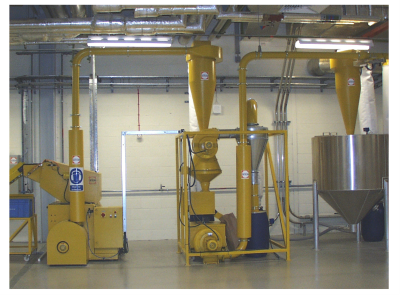Faulty parts from the injection moulding shop should be ground with a throughput of 200 – 300 kg/hr with the lowest possible manpower. The faulty parts are collected in containers and emptied into the equipment by the operator. The containers are not fed individually but several one after another.
The ground material must be dust-free and the regrind sizes must be within a small distribution range. Possible metallic impurities must be safely removed automatically. The ground material is filled into four different containers.
Installation:
The plastic parts have small dimensions (smaller than 100 mm) and can be easily tipped or dosed from a container.
- The containers are emptied into a large buffer container. The discharge chute of the container doeses the injection moulded parts onto the belt conveyor by means of vibration. The belt conveyor feeds the granulator RS 3004.
- A metal detector is integrated in the belt conveyor. Metal alarm activates a pneumatic flap at the hopper entrance of the granulator. The contaminated material is collected in boxes and can be checked by the operators at a suitable time.
- The granulator RS 3004 runs with a rotor revolution of 300 Upm, thus ensures a low noise level and very low-dust regrind.
- A transport blower conveys the regrind to a dedusting unit. The air separation process produces 99,9 % dust-free regrind.
- This regrind is checked again by an all-metal separator.
- A conveying blower transports the regrind to three storage containers. The containers can be individually controlled by pneumatic change-over valves. Filling level sensors inform about the filling level in the containers.
- A small PLC controls the automatic feeding of the granulator according to its working load and fills the regerind into the provided containers one after the other.


